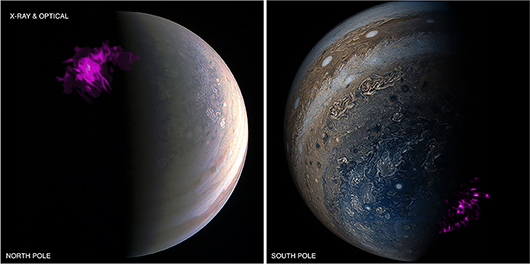
All around the world people enjoy watching fireworks, whether it's 5th November, or July 4th, Chinese New Year or Diwali.
But nature offers an even more impressive light show. Thanks to the planets' magnetic fields and violent explosions of energy on our Sun, we have the "aurora".
The aurora are shimmering curtains of glowing light that dance across the night sky at the north and south poles. They can be seen on some of the planets in our Solar System, painting the skies in reds, blues, greens and even X-rays. This picture shows X-ray aurora that have been seen for the first time, lighting up Jupiter's north and south poles.
Until recently, we thought that anything that affects one part of a planet's magnetic field would affect the magnetic field of the whole planet. It would explain why the aurora at the north and south poles on Earth mirror each other. But Jupiter isn't playing by these rules — aurora on Jupiter behave differently at each pole.
The aurora at Jupiter's south pole flash X-rays every 11 minutes or so, like clockwork. While the north pole seems to brighten and dim at random.
Astronomers aren't sure exactly what's causing this odd behaviour, but it's something they're keen to puzzle out.
Cool fact: Each of the aurora hot spots on Jupiter cover an area equal to about half the surface of the Earth!
Watch the video podcast
Do you want to learn more about this topic?
Visit the Chandra field guide or send us your questions in an email: cxcpub@cfa.harvard.edu
In cooperation with Space Scoop: Bringing news from across the Universe to children all around the world. Universe Awareness and the Chandra X-ray Observatory
| Children & Online Privacy |



